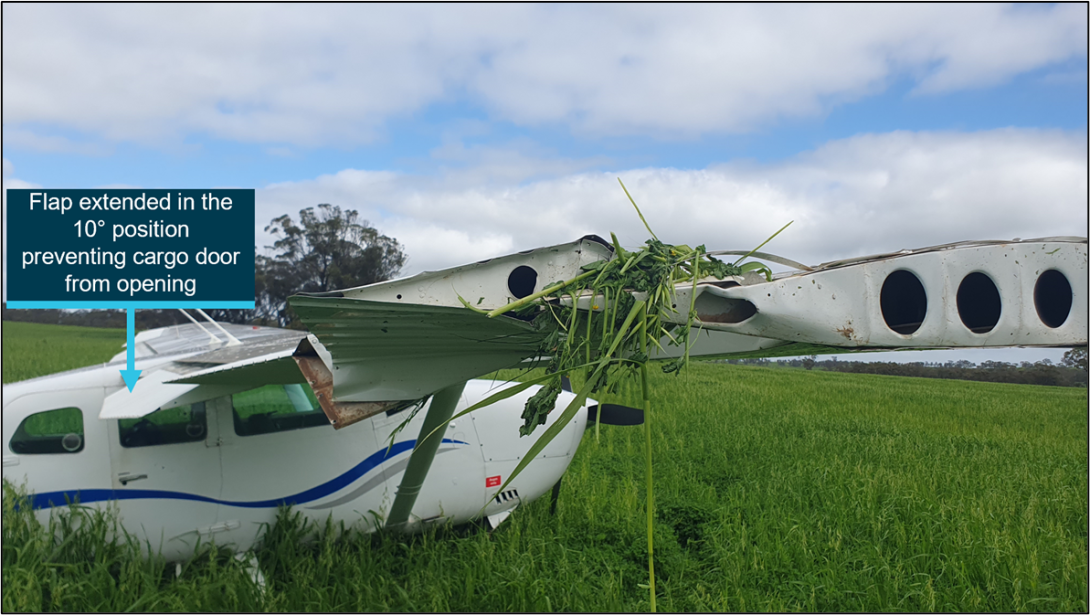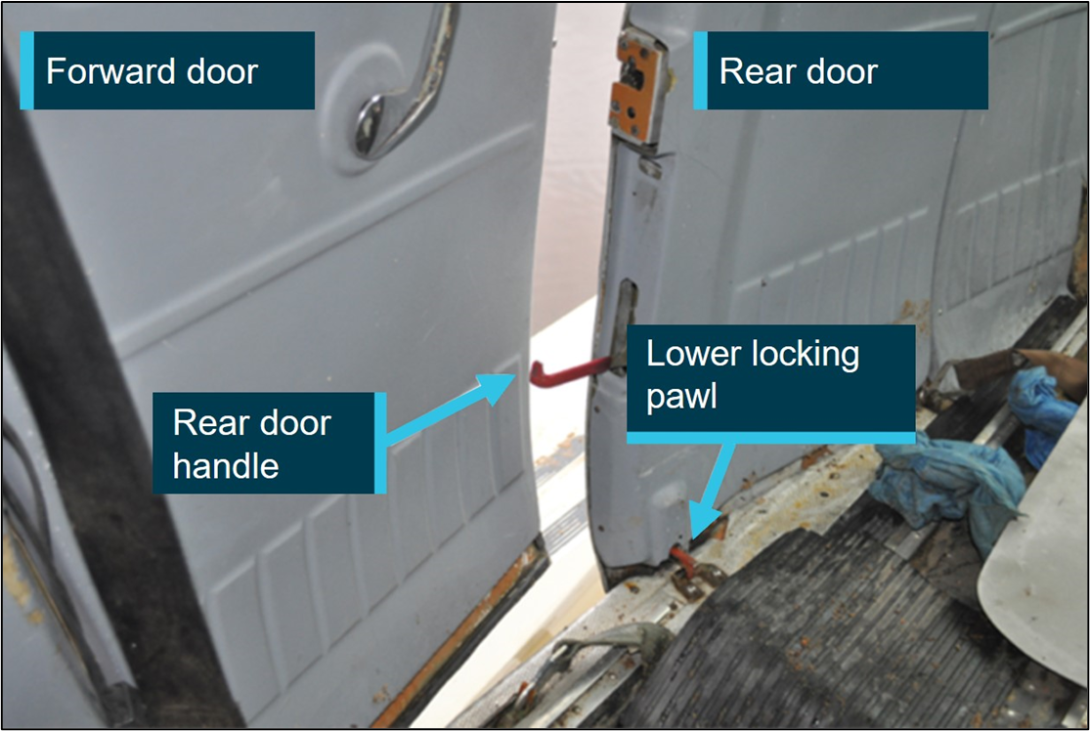Safety advisory notice
To operators of all Cessna 206 variants
Emergency egress from the rear cargo doors becomes more complex with flaps extended.
Ensure passengers have a thorough understanding of the use of emergency exits.
What happened
On the morning of 1 September 2024, the pilot of a Cessna U206F took off from a private aircraft landing area, 40 km south‑east of Moora, Western Australia, to conduct a local scenic flight with 5 passengers on board. On return to the landing area, after bouncing twice on landing, the pilot then attempted to conduct a go‑around. However, an incorrect flap setting resulted in the aircraft not climbing, impacting the right wing with terrain before coming to a stop in an adjacent field.

The rear seat passengers, an older person and a child, were unable to egress the aircraft via their closest emergency exit (the cargo doors). The pilot tried assisting them but found that the forward cargo door was blocked due to the flap extension and was unaware how to open the rear cargo door with the forward cargo door blocked by the flap. The pilot attempted to retract the flaps so the door could be opened, but they would not retract. The pilot then instructed the passengers in the rear seats to climb over the middle row of seats so they could exit through the left forward cabin door. This ultimately increased the time taken to evacuate the aircraft and further increased the risk of passenger injury and post-impact survivability, such as if fire or ditching had been a factor.
Why did it happen
The Cessna 206 is a 6‑seat, high wing aircraft with a forward cabin door on the pilot’s side and a double cargo ‘clam-shell’ style door on the rear right hand side of the aircraft. When the aircraft flaps are extended 10° or more, this prevented the forward, overlapping part of the cargo door from opening, requiring a multi-step process to open the rear part of the door to exit the aircraft.
The pilot reported they provided the passengers with a pre-flight briefing that included the operation of both the forward and rear cargo doors, however the briefing did not include a demonstration of the operation of the cargo door emergency exit with the flaps extended.
The emergency exit placard located on the forward cargo door states:
- Open forward cargo door as far as possible
- Rotate red lever in rear cargo door forward and unlatch/open door
- Restow red lever
- Force rear cargo door open

During landing and take-off, it is likely there will be flap extension and therefore also likely that the flaps would remain extended after a forced landing, ditching or accident, making the egress via the rear cargo doors more difficult for passengers.
The newer Cessna 206H model incorporates the improvements that were made with the 1991 Cessna service bulletin SEB 91-4 Cargo door latch improvement applicable to all models prior to the Cessna 206H. The service bulletin recommended modifying the rear door handle to include a spring to ensure that the handle would return to the stowed position after opening, this improved the ease of opening the rear cargo door when the flaps remained extended. The service bulletin was not a mandatory modifcation.
In 2021, the Civil Aviation Safety Authority (CASA) issued Airworthiness Bulletin 52‑006 recommending that pilots demonstrate the operations of the cargo door emergency exit with the flaps in an extended position. This was further revised by CASA in January 2025 to detail advice on placarding or fitment of the ‘return spring’ on the emergency release handle.
Safety advisory notice
AO-2024-049-SAN-001: The Australian Transport Safety Bureau advises Cessna 206 pilots and operators that due to the difficulties occupants have encountered egressing the rear cargo door as identified in several transport safety investigations, to ensure they are familiar with CASA‑issued Airworthiness Bulletin 52‑006, and ensure passengers are provided with a thorough safety briefing demonstrating the cargo door emergency egress when the wing flaps remain in the extended position.
Cargo door emergency egress briefing
The emergency egress via the cargo door is hampered by the extension of flaps and the process to evacuate when the flaps are extended is neither simple nor obvious. The ATSB has identified that this presents a high risk to passengers, particularly those seated in the rear of the aircraft.
Pilots and operators are encouraged to ensure passengers of Cessna 206 aircraft with the standard double cargo doors are provided a pre-flight safety briefing that demonstrates the emergency egress process required to use the cargo doors when the flaps are in the extended position. Operators are encouraged to develop safety briefing cards with imagery clearly depicting the process as well as incorporating into the passengers’ pre-flight briefing. The incident also highlights the responsibilities of pilots to ensure passengers have a thorough understanding of the use of emergency exits.
Read more about this ATSB investigation: Collision with terrain during go-around involving Cessna U206F, VH-TDQ, 39 km south-east of Moora, Western Australia, on 1 September 2024


